Author Archives: Darren Irwin
Nature Communications paper published by Dr. Silu Wang
Aside
Congratulations to lead author Dr. Silu Wang and coauthors on the publication of a paper on the history and genomic makeup of coastal populations of Setophaga townsendi, pictured here (photo by D. Irwin):
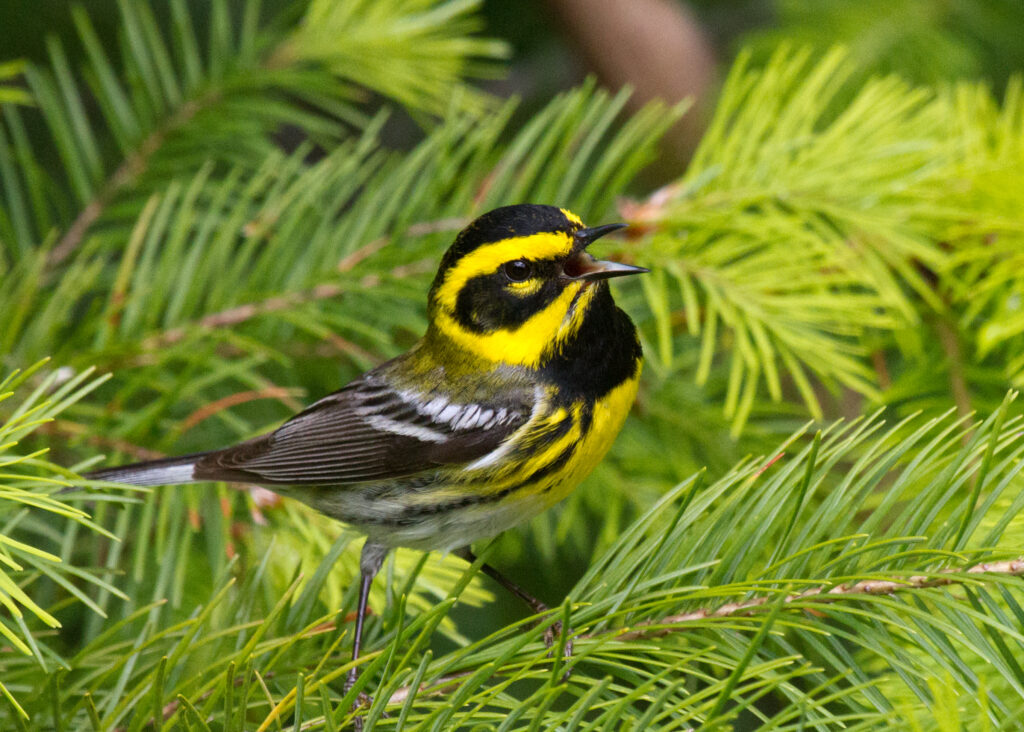
Silu and I are grateful for the contributions of coauthors Maddie Ore, Else Mikkelsen, Julie Lee-Yaw, David Toews, and Sievert Rohwer.
The full citation:
Wang, S., M.J. Ore, E.K. Mikkelsen, J. Lee-Yaw, D.P.L. Toews, S. Rohwer, and D. Irwin. 2021. Signatures of mitonuclear coevolution in a warbler species complex. Nature Communications 12: 4279. https://doi.org/10.1038/s41467-021-24586-8
The abstract:
Divergent mitonuclear coadaptation could facilitate speciation. We investigate this possibility in two hybridizing species of warblers, Setophaga occidentalis and S. townsendi, in western North America. Inland S. townsendi harbor distinct mitochondrial DNA haplotypes from those of S. occidentalis. These populations also differ in several nuclear DNA regions. Coastal S. townsendi demonstrate mixed mitonuclear ancestry from S. occidentalis and inland S. townsendi. Of the few highly-differentiated chromosomal regions between inland S. townsendi and S. occidentalis, a 1.2 Mb gene block on chromosome 5 is also differentiated between coastal and inland S. townsendi. Genes in this block are associated with fatty acid oxidation and energy-related signaling transduction, thus linked to mitochondrial functions. Genetic variation within this candidate gene block covaries with mitochondrial DNA and shows signatures of divergent selection. Spatial variation in mitonuclear ancestries is correlated with climatic conditions. Together, these observations suggest divergent mitonuclear coadaptation underpins cryptic differentiation in this species complex.
Below is figure 1 from the paper, showing Silu’s beautiful graphics, and you can see more interesting figures here.
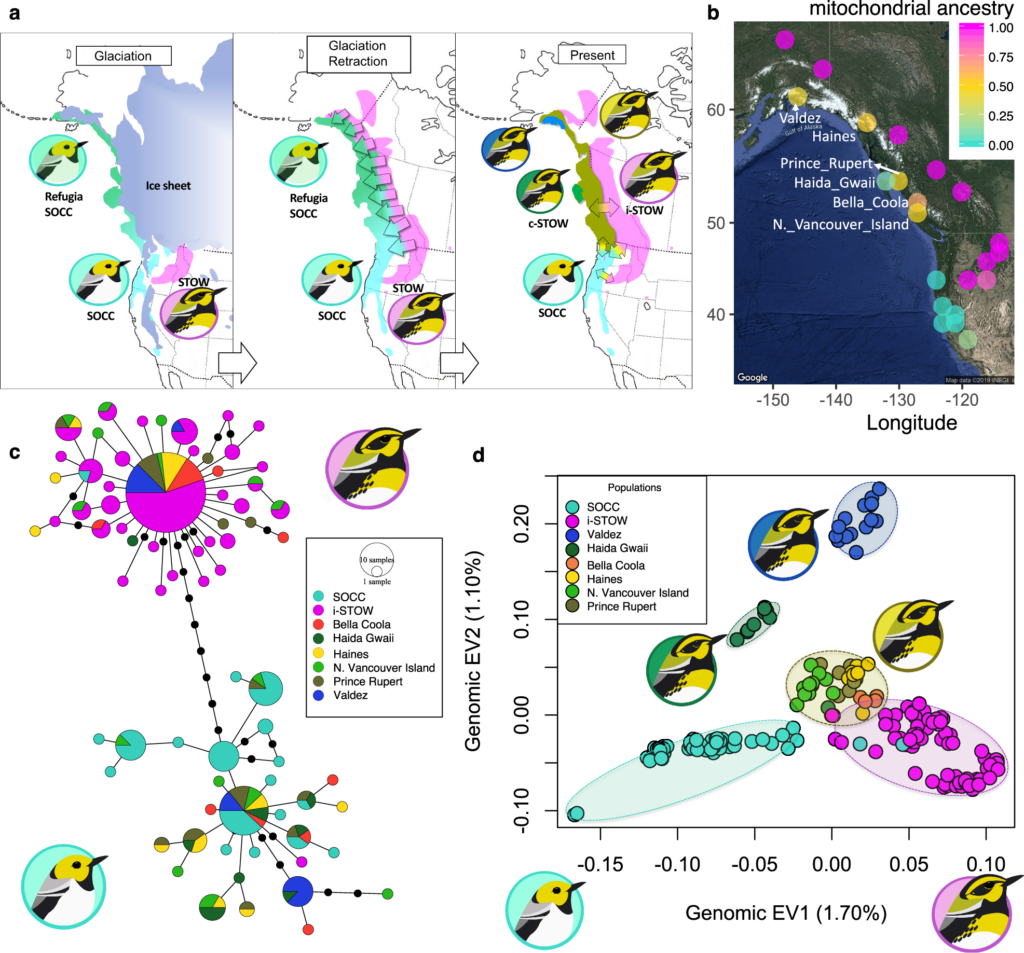
Else Mikkelsen publishes on genomics of wrens
Aside
Congratulations to Else Mikkelsen on the publication of her excellent Honours Thesis work on genomic differentiation between Pacific and Winter Wrens.
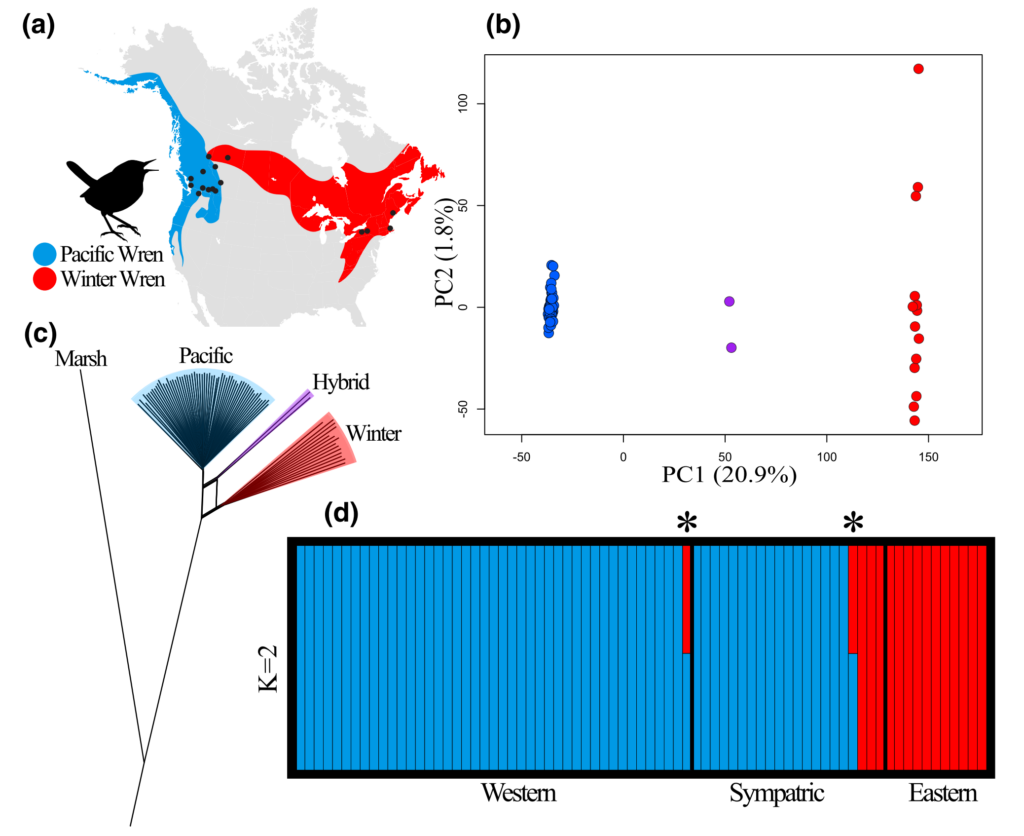
The full citation:
Mikkelsen, E.K., and D. Irwin. 2021. Ongoing production of low-fitness hybrids limits range overlap between divergent cryptic species. Molecular Ecology, online early view: https://doi.org/10.1111/mec.16015 .
The abstract:
Contact zones between recently diverged taxa provide opportunities to examine the causes of reproductive isolation and the processes that determine whether two species can coexist over a broad region. The Pacific wren (Troglodytes pacificus) and winter wren (Troglodytes hiemalis) are two morphologically similar songbirds that started diverging about 4 million years ago, older than most sister species pairs of temperate songbirds. The ranges of these species come into narrow contact in western Canada, where the two species remain distinct. To assess evidence for differentiation, hybridization and introgression in this system, we examined variation in over 250,000 single nucleotide polymorphism markers distributed across the genome. The two species formed highly divergent genetic clusters, consistent with long-term differentiation. In a set of 75 individuals, two first-generation hybrids (i.e., F1’s) were detected, indicating only moderate levels of assortative mating between these taxa. We found no recent backcrosses or other evidence of recent breeding success of F1’s, indicating very low or zero fitness of F1 hybrids. Examination of genomic variation shows evidence for only a single backcrossing event many generations ago. The moderate rate of hybridization combined with very low F1 hybrid fitness is expected to result in a population sink in the contact zone, largely explaining the narrow overlap of the two species. If such dynamics are common in nature, they could explain the narrow range overlap often observed between pairs of closely related species.
To read a Twitter thread about the paper, click here.
Dr. Wang publishes Evolution Letters paper on genetic basis of warbler plumage
Aside
Congratulations to lead author Dr. Silu Wang who has published another excellent paper on the hybrid zone between two beautiful warbler species, Setophaga occidentalis (Hermit Warbler) and Setophaga townsendi. Here is Silu’s beautiful painting inspired by the hybrid zone:
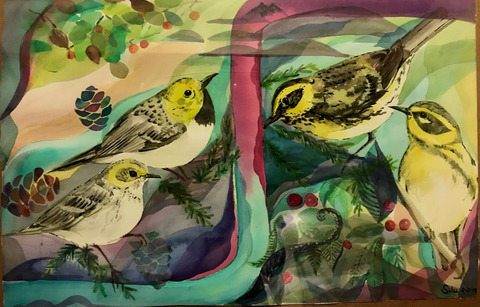
Silu and I are grateful to the contributions of coauthors Sievert Rohwer, Devin de Zwaan, David Toews, Irby Lovette, and Jacqueline Mackenzie.
The full citation:
Wang, S., S. Rohwer, D.R. de Zwaan, D.P.L. Toews, I.J. Lovette, J. Mackenzie, and D. Irwin. 2020. Selection on a small genomic region underpins differentiation in multiple color traits between two warbler species. Evolution Letters, online Early View; https://doi.org/10.1002/evl3.198
The abstract:
Speciation is one of the most important processes in biology, yet the study of the genomic changes underlying this process is in its infancy. North American warbler species Setophaga townsendi and Setophaga occidentalis hybridize in a stable hybrid zone, following a period of geographic separation. Genomic differentiation accumulated during geographic isolation can be homogenized by introgression at secondary contact, whereas genetic regions that cause low hybrid fitness can be shielded from such introgression. Here, we examined the genomic underpinning of speciation by investigating (1) the genetic basis of divergent pigmentation traits between species, (2) variation in differentiation across the genome, and (3) the evidence for selection maintaining differentiation in the pigmentation genes. Using tens of thousands of single nucleotide polymorphisms (SNPs) genotyped in hundreds of individuals within and near the hybrid zone, genome‐wide association mapping revealed a single SNP associated with cheek, crown, breast coloration, and flank streaking, reflecting pleiotropy (one gene affecting multiple traits) or close physical linkage of different genes affecting different traits. This SNP is within an intron of the RALY gene, hence we refer to it as the RALY SNP. We then examined between‐species genomic differentiation, using both genotyping‐by‐sequencing and whole genome sequencing. We found that the RALY SNP is within one of the highest peaks of differentiation, which contains three genes known to influence pigmentation: ASIP, EIF2S2, and RALY (the ASIP‐RALY gene block). Heterozygotes at this gene block are likely of reduced fitness, as the geographic cline of the RALY SNP has been narrow over two decades. Together, these results reflect at least one barrier to gene flow within this narrow (∼200 kb) genomic region that modulates plumage difference between species. Despite extensive gene flow between species across the genome, this study provides evidence that selection on a phenotype‐associated genomic region maintains a stable species boundary.
To read a Twitter thread about the paper, click here.
To read Silu’s blog about this paper on the Evolution Letters website, click here.
Congrats to Dr. Saminda Fernando!
Aside
Congratulations to Saminda Fernando, who presented an excellent defence of his dissertation this morning in Sri Lanka. The examining committee was unanimously impressed with Saminda’s presentation and dissertation, titled “Barriers to gene flow and the resulting endemism in an island endemic: phenotypic divergence and genetic introgression in Dinopium flamebacks of Sri Lanka.” Saminda’s main advisor is Dr. Sampath Seneviratne, who was a postdoc in the Irwin lab Senior Lecturer at the University of Colombo; and I serve as co-advisor.
During this time of COVID19, the defence was conducted over Zoom, which had the added benefit of making it easy for me to “attend.” Below are some photos from the defence:
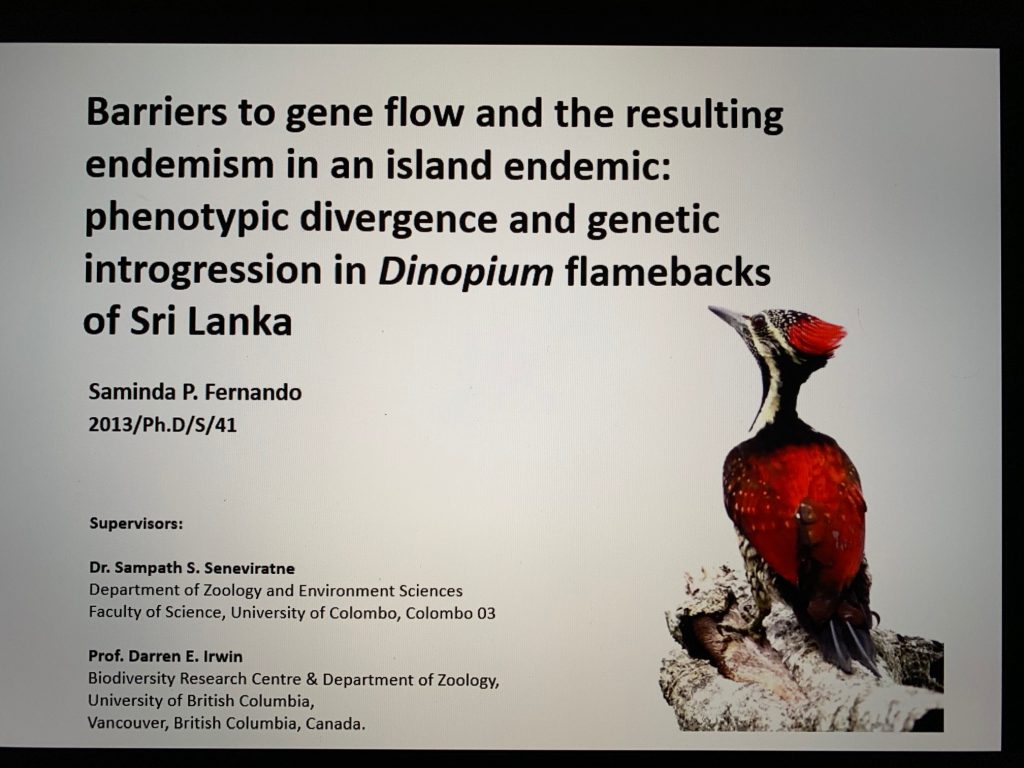
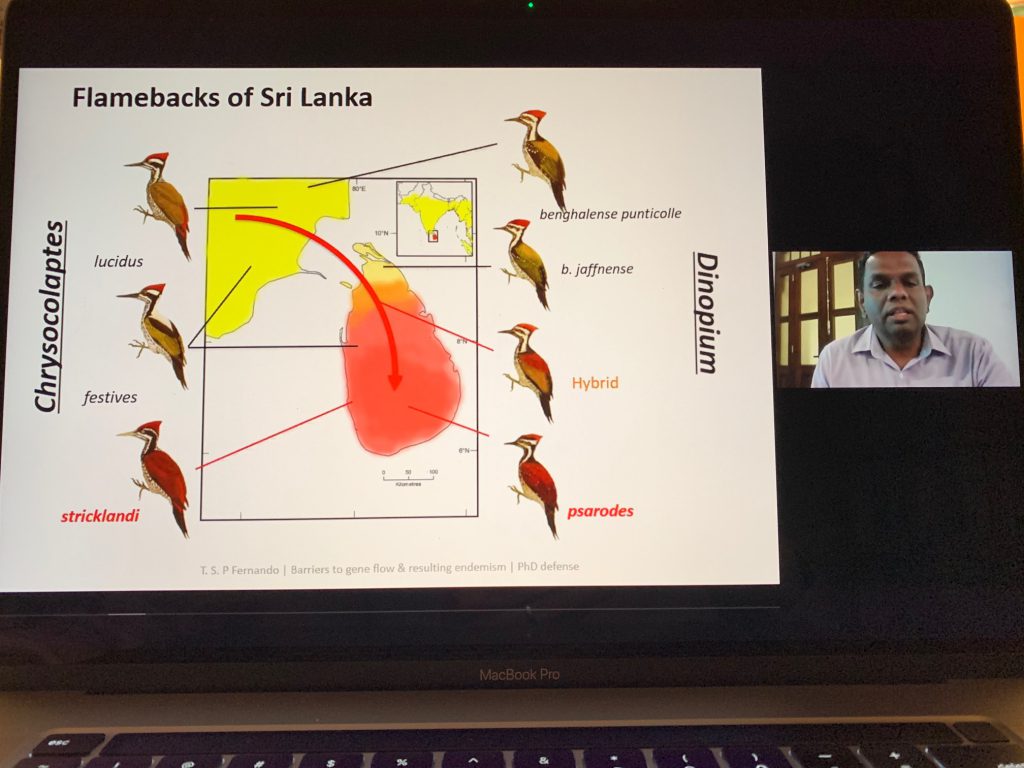
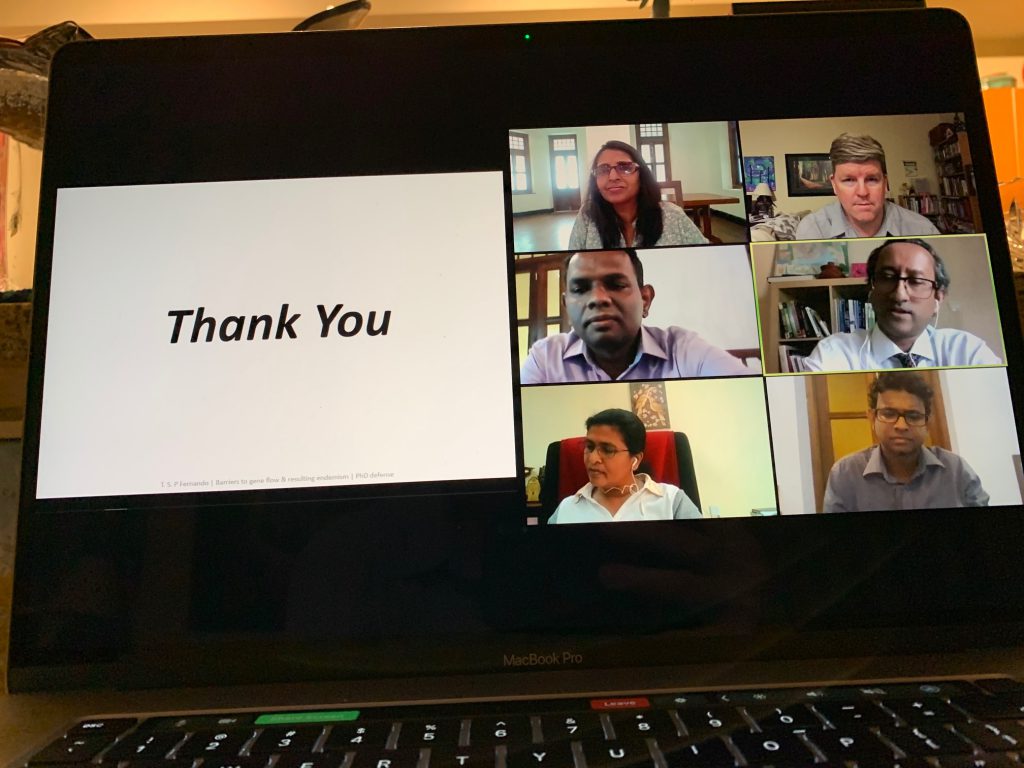
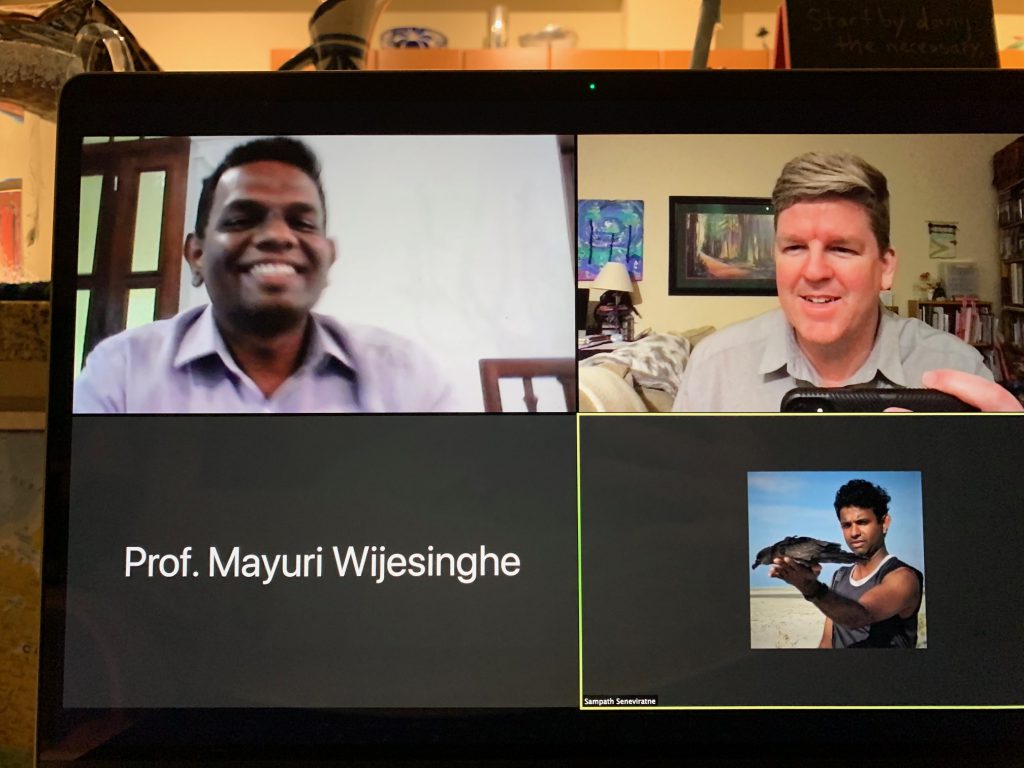
And here is a photo from when Saminda worked with us here in Vancouver for several months in 2016:
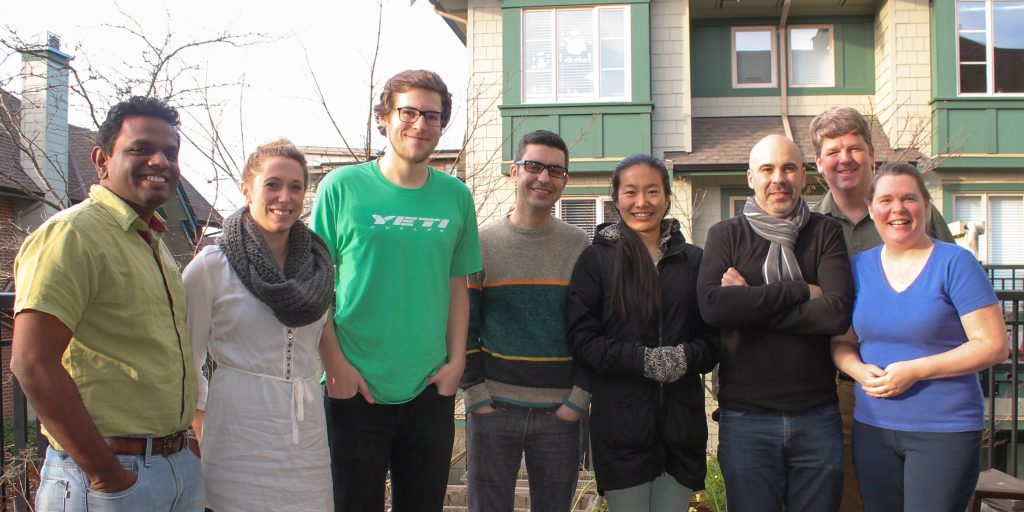
We all wish Dr. Fernando a very warm CONGRATULATIONS!!
If you would like to read more about Saminda’s work, see:
https://www.sanctuaryasia.com/conservation/field-reports/9853-flaming-mysteries.html
https://academic.oup.com/auk/article/133/3/497/5149242
https://evolution.cmb.ac.lk/index.php/research/
Denouncing racism; Celebrating #BlackBirdersWeek
Aside
June 5th, 2020
Dear Colleagues, Friends, Biodiversity Biologists,
I have been committed to promoting equality and diversity in science and society in general for many years. My personality leads me to do this in a rather quiet way, focusing on calmly promoting diversity through hiring, student admissions, inclusive teaching, and occasionally participating in marches or protests. The recent events in the USA, with the profoundly racist Federal administration, widespread police brutality against non-violent protesters, and the abundant evidence of widespread and possibly worsening racism, have convinced me that this quiet approach is no longer appropriate (full confession: it never was). I am now striving not only to be non-racist but to more importantly be actively and vocally anti-racist (as well as anti-sexist, etc.).
As a biologist, birder, and biodiversity scientist, I now recognize that I have had an advantage due to my skin color as well as my gender: I have been able to travel widely across Canada, the USA, and many other countries without fear that I would be judged as suspicious due solely to my physical appearance. This is not the case for many many people, and I feel it is the responsibility of those of us with that privilege to recognize this fact and work to change it. I also recognize that I have much to learn about the experiences that other people have had. Hence, one thing I have been focusing on in the last week is listening carefully.
We often have discussions and initiatives within academia about promoting diversity in our hiring, student recruitment, and teaching. These are all important efforts that I fully support, and they should continue. I think the past week of protests in the USA and elsewhere have raised the importance of working even more broadly. Many of us are attracted into careers in biology due to early experiences out in nature. If many people do not have the same ability to go out into nature due to their skin color or gender, that is something that we need to recognize and work to change.
Many of us have watched in horror during the past week at some of the events in the USA, and we have wondered how we individually can improve things (both internationally and within Canada and Vancouver, for we of course have related issues here). For me, it has been a wonderful experience to follow an amazing and self-organized group of biologists organized under the Twitter hashtags #BirdingWhileBlack, #BlackBirdersWeek, and under the name @BlackAFinSTEM. For a short introduction to the motivation behind this group, please see this video by Corina Newsome. This group is effecting real change by educating the world about these problems while also doing so in a way that celebrates diversity, inclusivity, positivity, and amazing stories of birds and other biodiversity. I applaud their efforts, and I am doing my best to listen carefully and do my part in amplifying their important message. I encourage you to check them out.
Yesterday, this inspiring group organized two discussion groups that make for equally sobering and inspiring viewing. It breaks my heart to hear of their experiences dealing with racism and how they have to avoid many areas that white birders don’t hesitate to go to. But my overall feeling listening to this group is one of inspiration: to approach life with courage, to embrace your own identity, to stand up for what you believe in, to display good humour and an open heart, and (perhaps most importantly 😉 ) to love birds! I think we all can learn much from these wise people.
These discussions were recorded and are available here: https://www.facebook.com/NationalAudubonSociety
If they are difficult to find on that link, try these:
Session 1: https://www.facebook.com/NationalAudubonSociety/videos/599256750697358
Session 2: https://www.facebook.com/NationalAudubonSociety/videos/250698879684486
And for those of you who care nothing about birds (hopefully none of you ;), this is all related to a broader movement under the #BlackInNature hashtag.
Sincerely,
Darren
#BlackLivesMatter
Published: Assortative mating and hybrid zones
Aside
Darren’s simulation study of the effects of assortative mating and low hybrid fitness on hybrid zones was published this week in The American Naturalist.
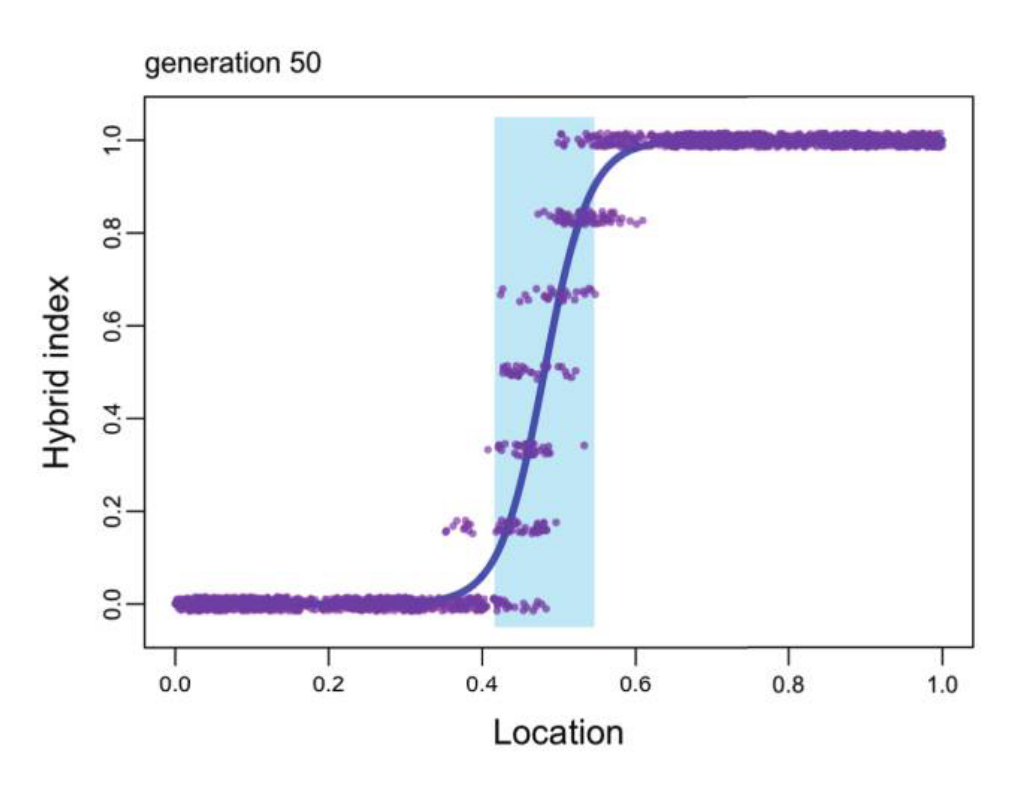
The citation:
Irwin, D.E. 2020. Assortative mating in hybrid zones is remarkably ineffective in promoting speciation. American Naturalist, published online May 4, 2020: Link
(earlier version posted on bioRxiv: Link )
The Abstract:
Partial prezygotic isolation is often viewed as more important than partial postzygotic isolation (low fitness of hybrids) early in the process of speciation. I simulate secondary contact between two populations (species) to examine effects of assortative mating and low hybrid fitness in preventing blending. A small reduction in hybrid fitness (e.g., by 10%) produces a narrower hybrid zone than a strong but imperfect mating preference (e.g., 10 times stronger preference for conspecific over heterospecific mates). In the latter case, rare F1 hybrids find each other attractive (due to assortative mating), leading to the buildup of a continuum of intermediates. The weakness of assortative mating compared with reduced fitness of hybrids in preventing blending is robust to varying genetic bases of these traits. Assortative mating is most powerful in limiting blending when it is encoded by a single locus or is essentially complete, or when there is a large mate search cost. In these cases assortative mating is likely to cause hybrids to have low fitness, due to frequency-dependent mating disadvantage of individuals of rare mating types. These results prompt a questioning of the concept of partial prezygotic isolation, since it is not very isolating unless there is also postzygotic isolation.
To see videos of example simulations, see here.
Ethan Linck converted the HZAM code to a web app where you can play with the parameters and watch how the model responds.
2nd annual snowshoeing trip
Aside
On Feb. 2nd, six lab members enjoyed a wonderful 3-hour snowshoe hike among the trails of Hollyburn Ridge at Cypress Mountain. The happy team:
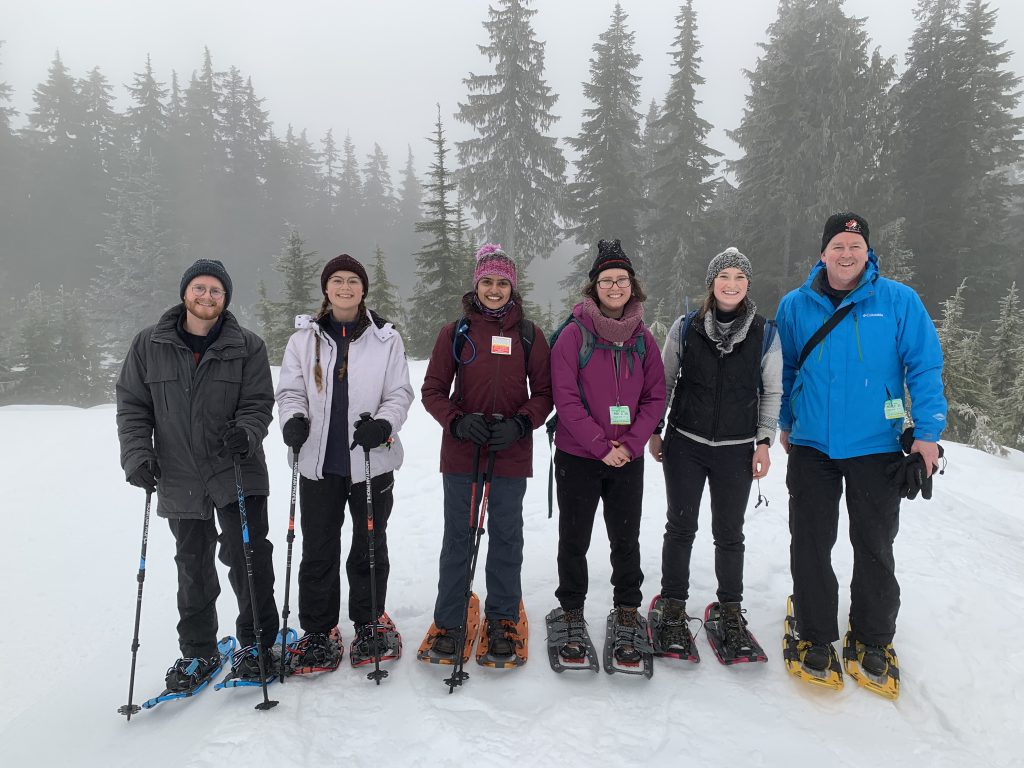
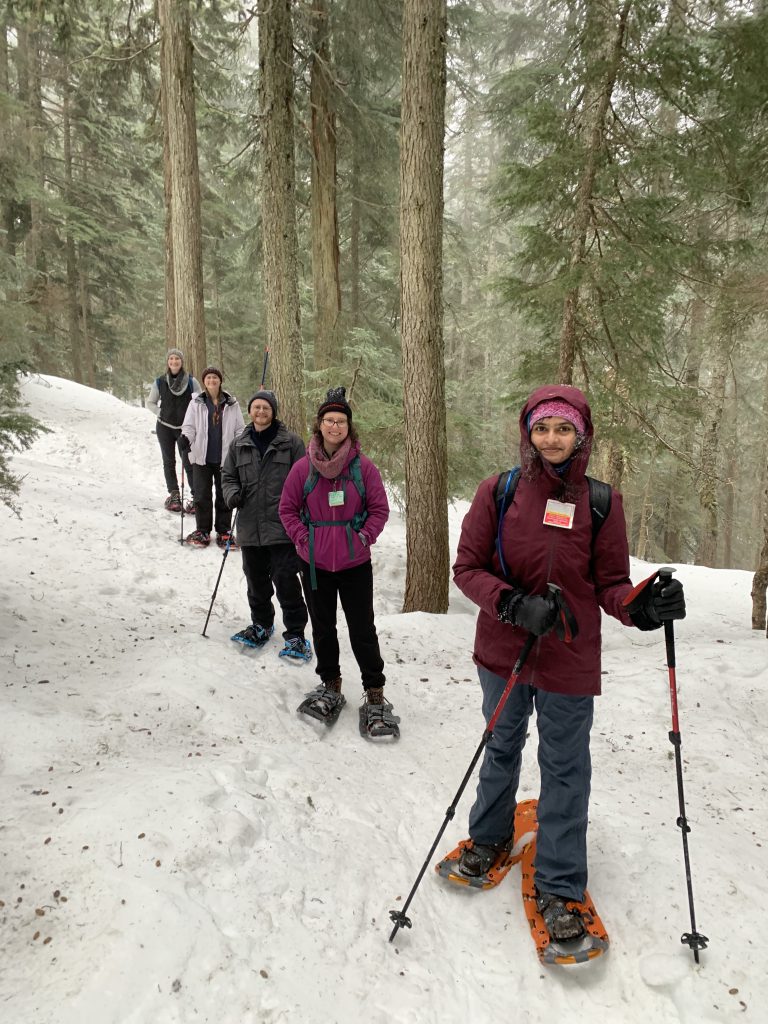
Congrats to Dr. Silu Wang!
Aside
On Wednesday, Dec. 4th, Silu gave an outstanding presentation and defence of her PhD dissertation, titled “Genomic Architecture of Speciation in a Warbler Species Complex.”
It has been a great pleasure to serve as Silu’s advisor. We all wish her well in her next scientific adventure, as a postdoctoral research in Dr. Doris Bachtrog’s research group at UC Berkeley.
Congratulations Dr. Wang!!!
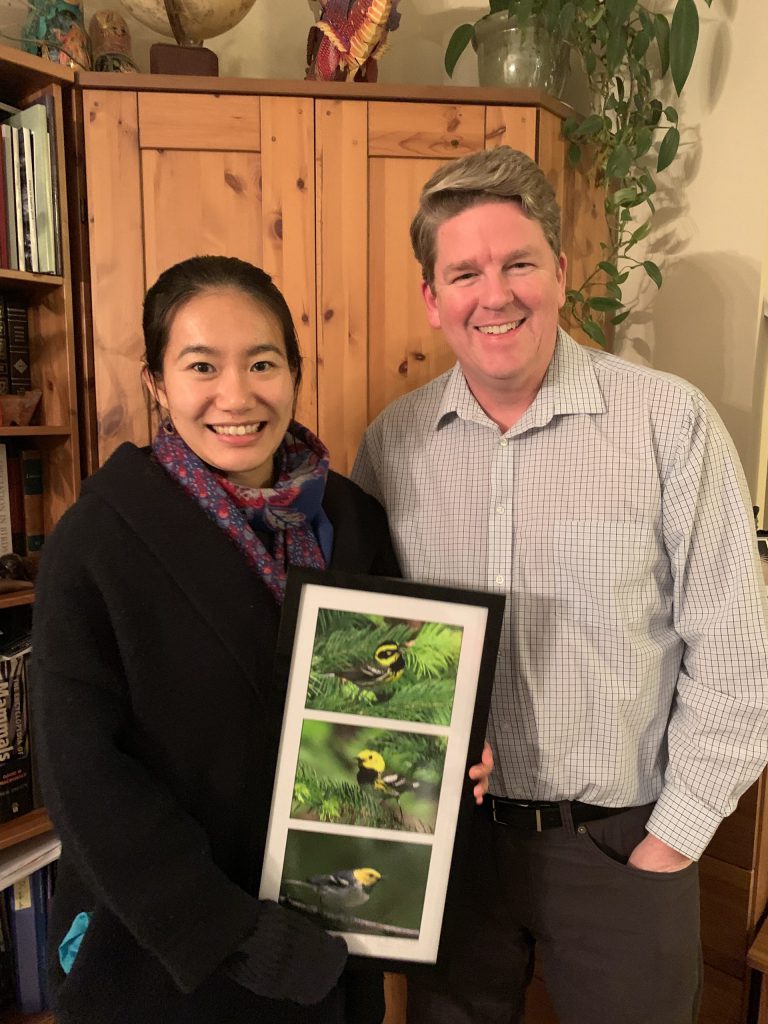
P.S. Silu’s first data chapter is published, and more are on the way. Here is the first from her PhD:
Wang, S., S. Rohwer, K. Delmore, and D.E. Irwin. 2019. Cross-decades stability of an avian hybrid zone. Journal of Evolutionary Biology 32: 1242-1251. Link
Silu Wang publishes JEB paper on stability of a warbler hybrid zone
Aside
Congratulations to Silu Wang, who has published her first paper on the Setophaga townsendi / Setophaga occidentalis hybrid zone, showing surprising stability of the zone over a period of 25 years.
Silu and I are grateful to coauthor Sievert Rohwer, who collaborated on this project and allowed access to his many samples of warbler tissues from the 1987-1994 time period. We also thank coauthor Kira Delmore for her contributions to the genomic analysis.
Here is Silu’s painting inspired by the hybrid zone:

The full citation:
Wang, S., S. Rohwer, K. Delmore, and D.E. Irwin. Cross-decades stability of an avian hybrid zone. Journal of Evolutionary Biology 32: 1242-1251. Link
The Abstract:
Hybrid zones are particularly valuable for understanding the evolution of partial reproductive isolation between differentiated populations. An increasing number of hybrid zones have been inferred to move over time, but in most such cases zone movement has not been tested with long‐term genomic data. The hybrid zone between Townsend’s Warblers (Setophaga townsendi) and Hermit Warblers (S. occidentalis) in the Washington Cascades was previously inferred to be moving from northern S. townsendi southwards towards S. occidentalis, based on plumage and behavioural patterns as well as a 2000‐km genetic wake of hermit mitochondrial DNA (mtDNA) in coastal Townsend’s Warblers. We directly tested whether hybrid zone position has changed over 2–3 decades by tracking plumage, mtDNA and nuclear genomic variation across the hybrid zone over two sampling periods (1987–94 and 2015–16). Surprisingly, there was no significant movement in genomic or plumage cline centres between the two time periods. Plumage cline widths were narrower than expected by neutral diffusion, consistent with a ‘tension zone’ model, in which selection against hybrids is balanced by movement of parental forms into the zone. Our results indicate that this hybrid zone is either stable in its location or moving at a rate that is not detectable over 2–3 decades. Despite considerable gene flow, the stable clines in multiple phenotypic and genotypic characters over decades suggest evolutionary stability of this young pair of sister species, allowing divergence to continue. We propose a novel biogeographic scenario to explain these patterns: rather than the hybrid zone having moved thousands of kilometres to its current position, inland Townsend’s met coastal Hermit Warbler populations along a broad front of the British Columbia and Alaska coast and hybridization led to replacement of the Hermit Warbler plumage with Townsend’s Warbler plumage patterns along this coastline. Hence, hybrid zones along British Columbia and Alaska moved only a short distance from the inland to the coast, whereas the Hermit Warbler phenotype appears stable in Washington and further south. This case provides an example of the complex biogeographic processes that have led to the distribution of current phenotypes within and among closely related species.
